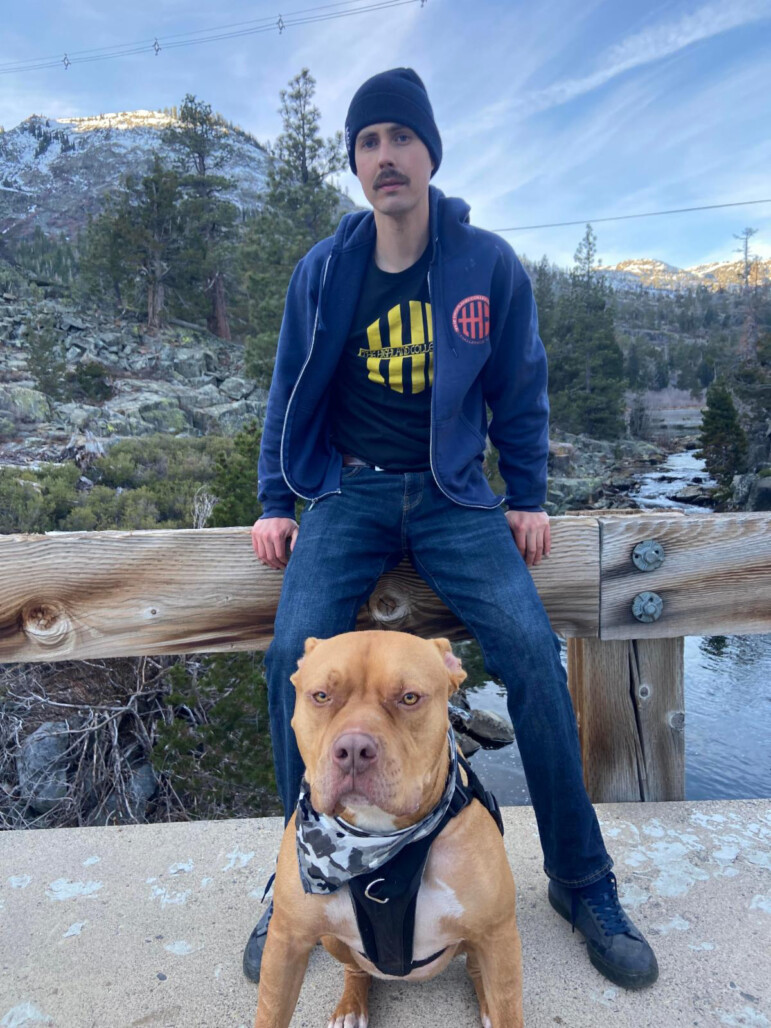
Looks can be deceiving.

[SPONSORED]
The personal stories of one Realtor’s battles and triumphs in the highly-competitive Bay Area Real Estate Market, seeking to illuminate and humanize the very real ups-and-downs of homeownership.
Sadly, last weekend, my son, had to put his dog down. While there are undoubtedly much tougher and far more profound losses in his future, Juice had become a valuable family member and four-legged friend, carrying our elder son through the isolation of COVID and well beyond.
Last year, we learned Juice had a rapidly growing brain tumor that was incurable . . . so we brought him home, showered him with affection, took him on long walks on the trails, and tried to keep him comfortable. Regrettably, his demise was inevitable, and having wasted away to nothing but skin and bones the last few months, putting him to sleep was both the humane and ethical thing to do. Even so, it was a heartbreaker to be sure, especially for Case, who fiercely loved and championed his dog like no other.
For me, Juice wasn’t love at first sight (more like an acquired taste).Truthfully, when Case brought him home, I was fit to be tied! He was a large, insecure pit bull with separation anxiety and a seemingly gruff exterior, and I was absolutely certain it was a bad idea. Like many people, I had preconceived notions about pit bulls, and this one specifically. Juice had a huge block head, the size of a car battery, and was 90 lbs. of pure, intimidating muscle with a deep and threatening bark that seemed to say, “enter at your own peril.” (Most people stayed clear.) With his prehistoric jaws and amber eyes that looked more crocodile than dog, the gardeners, housekeepers, mailmen, and Amazon drivers wanted nothing to do with him, throwing packages over the fence before quickly sprinting back to the safety of their vans. Never mind that he was actually a big ol’ marshmallow when you got to know him (or more accurately, when he got to know YOU). The lesson he imparted still holds true: “you can’t judge a book by its cover.”
Here’s the thing, selling houses for top-dollar demands a first impression that creative Agents carefully curate and craft – a “cover” so to speak. If we don’t present beautiful and compelling photos and videos online – designed to stand out and attract attention – Sarah and I are unlikely to get Buyers across the threshold, which, in turn, can make it tough to sell your property.
Consequently, repairing, painting, staging and gardening are the minimum investments when updating a house for the market, with bathroom and kitchen updates often being part of the preparation process as well. (Selling isn’t for the faint of heart, nor for those who are not action-oriented or solution-driven.)
To put it more succinctly, it’s our job to create a narrative that plays directly into people’s dreams. If there are any shortcomings regarding the house (and we’ve yet to sell the “perfect” property), we are purposefully steering the eye toward those attributes that are more persuasive, and away from anything that might present as a hurdle, including musty basements, nonfunctioning windows, or grandma’s old furniture. I appreciate that it’s how most people live, but it’s NOT how most Buyers buy!
That being said, we’re not in the business of “covering up” defects; that’s where disclosures come in. With more than 40-50 documents in the average disclosure package, ethical Agents do their best to create a comprehensive representation of the house and property so that Buyers can be well informed PRIOR to writing an offer. And because so many offers are now “contingency-free,” the more information provided upfront, the better, and the less likely Sellers will be confronted with an after-the-fact lawsuit for non-disclosure or unexplained discovery. (Cover-ups are for those in the political arena.)
However, even with hundreds of pages of documents at the ready, Inspectors are human. Sellers have fungible memories, Agents typically don’t have any knowledge of the house before acquiring the listing, and disclosures – no matter how thorough – are an imperfect tool at best. Moreover, there’s an argument to be made that Buyers bear some responsibility to conduct their own due diligence, investigate as needed, question the reports, and figure out what “unknowns” you are willing to accept . . . and what you are unable to tolerate.
Given that much of our housing stock is more than 100 years old, invariably, there are going to be items that are missed, despite our best efforts. As a potential Buyer, you’ll need to decide what’s important to you, what you can live with, and what level of risk you’re willing to take on. In short, home ownership is a GIGANTIC leap of faith. (Grab a parachute and jump.)
Looking at a very pretty house last weekend with a potential Buyer, the reports noted that there were many signs of past stucco repair, issues with the roof and flashings, and redwood gutters that had failed and been replaced. Additionally, there was fungus and dry rot throughout, and previous water intrusion. Unfortunately, the pest report stopped short of recommending test holes, which might have told us if there was rot behind the stucco as well. Thus, when asked about my thoughts on the property, which, on the surface, presented quite beautifully, I could only answer: “There’s some risk here; how comfortable are you with the unknown?” (Turns out, not very.)
To be fair, every structure is going to have some “unknowns” as no one has yet created the comprehensive PET scan for buildings (pest inspections typically address the exterior walls and decks only) meaning that interior walls might have damage behind the drywall that’s impossible to identify. (I speak from experience, having discovered boards that looked like Swiss cheese instead of healthy framing during a remodeling project.) If you plan on a major renovation, many of these defects will be corrected in due course and won’t ultimately matter. If you don’t, that might be another story altogether. Dry rot doesn’t improve or self-correct over time, nor do bad roofs, improper earthquake retrofitting, cracked sewer laterals, or old and outdated anything! None of it improves with age.
Finally, with insurance now becoming one of the major roadblocks regarding homeownership, keep in mind that it is often the stuff that’s “undercover,” or not being said that’s liable to cost you money, especially if you must replace knob & tube wiring, older roofs, galvanized pipes, and outdated furnaces, to insure the home. (Please budget accordingly.)
So while the pictures online might be beautiful, visit the house in person, dive deep, ask questions, be curious, and read the disclosures thoroughly, because looks can definitely be deceiving.
In the end, Juice turned out to be a love bug and one hell of a dog. R.I.P., sweet friend.
How can we help you?
Julie Gardner & Sarah Abel | Compass Realty
Not just Realtors, but consultants in all things house and home, we’re here to educate, explore, examine and refer . . . In short, you may count on us to take care of your home as if it were our own and anyone who knows us, knows we take pretty darn good care of our homes.
Learn MORE
